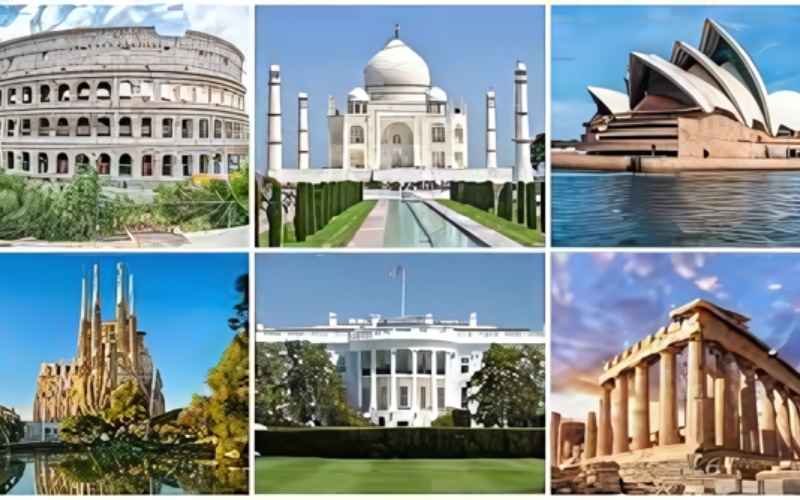The world is home to countless architectural wonders, each telling a unique story of cultural heritage, innovation, and artistry. Here are ten of the most famous buildings globally, celebrated for their iconic designs and historical significance.

1. The Eiffel Tower, Paris, France
The Eiffel Tower, an iconic symbol of Paris, France, stands as one of the most recognizable structures in the world. Erected as the centerpiece for the 1889 Exposition Universelle (World’s Fair), the tower was intended to celebrate the centennial of the French Revolution and showcase France’s industrial prowess.
Highlights:
- Height: The Eiffel Tower reaches a staggering height of 324 meters (1,063 feet), making it the tallest structure in Paris and one of the tallest in the world when it was built. It held the title of the world’s tallest man-made structure until the completion of the Chrysler Building in New York in 1930.
- Designed by: Gustave Eiffel, a renowned engineer, and his company designed and built the tower. While Eiffel himself often gets the credit, the actual design was the work of Maurice Koechlin and Émile Nouguier, two senior engineers in Eiffel’s company, with architectural input from Stephen Sauvestre.
- Construction: The construction of the Eiffel Tower was an engineering marvel of its time. It took two years, two months, and five days to complete, involving about 300 workers who assembled more than 18,000 iron parts using 2.5 million rivets. Despite its massive scale, the tower was completed on time and within budget.
Fun Fact:
The Eiffel Tower was initially met with widespread criticism from many of France’s leading artists and intellectuals. They condemned the structure’s bold, industrial design, which they felt clashed with the city’s classic beauty and architectural harmony. A group of 300 prominent Parisians, including the novelist Guy de Maupassant, published a public protest letter in the newspaper Le Temps, calling the tower “useless and monstrous.” However, these sentiments quickly dissipated as the tower became a beloved landmark and a symbol of modernity and artistic daring.
Cultural Significance:
Over time, the Eiffel Tower has evolved from a temporary exhibition structure into a lasting icon of France. It is often associated with romance, thanks to its picturesque views and the countless love stories that have unfolded in its shadow. The tower has inspired countless artists, filmmakers, and photographers, contributing to its status as a cultural and artistic beacon.
Modern-Day Use:
Today, the Eiffel Tower attracts nearly seven million visitors each year, making it one of the most visited paid monuments in the world. It offers breathtaking views of Paris from its three levels, which house restaurants, shops, and exhibits detailing the tower’s history. The top level, accessible by a combination of elevator and stairs, provides an unparalleled panoramic view of the city.
2. The Great Wall of China, China
The Great Wall of China stands as one of the most impressive architectural feats in human history, a testament to both the ingenuity and the determination of the ancient Chinese civilization. Spanning over 13,000 miles across northern China, it is a series of walls, fortifications, and watchtowers constructed over centuries with the primary purpose of defending against invasions and raids from nomadic tribes and other adversaries.
Highlights:
- Construction Period: The construction of the Great Wall spans over an astonishing timeframe, beginning as early as the 7th century BC and continuing through various dynasties until the 16th century. It wasn’t a single, unified project but rather a series of wall-building efforts undertaken by different Chinese states and dynasties over centuries, each contributing to the overall structure we recognize today.
- Design and Architecture: The Great Wall’s design varied over time and across regions, reflecting the technological advancements and strategic needs of different eras. Initially built using earth, wood, and other local materials, the wall was later reinforced with brick and stone under the Ming Dynasty. It comprises not only walls but also watchtowers, barracks, and signal towers, strategically positioned along its length to provide defense and communication capabilities.
- Cultural Significance: Beyond its military function, the Great Wall holds immense cultural significance for the Chinese people and has become a symbol of national pride and identity. It is a UNESCO World Heritage Site and one of the most iconic symbols of China, attracting millions of visitors annually from around the world.
Fun Fact:
Contrary to popular belief, the notion that the Great Wall is visible from space with the naked eye is a myth. While the wall is indeed an impressive structure, its width and color make it indistinguishable from its surrounding terrain when viewed from space without aid. However, with the assistance of telescopic lenses or satellite imagery, certain sections of the wall can be discerned.
Modern-Day Importance:
Today, the Great Wall of China not only serves as a historical and cultural landmark but also as a major tourist attraction and a symbol of China’s enduring strength and resilience. Visitors can explore various sections of the wall, each offering unique insights into its construction, history, and significance. Preservation efforts are ongoing to protect and maintain this invaluable heritage site for future generations.
3. The Colosseum, Rome, Italy
The Colosseum, also known as the Flavian Amphitheater, stands as a timeless testament to the grandeur and engineering prowess of the Roman Empire. This iconic structure served as the epicenter of entertainment and spectacle in ancient Rome, hosting a wide array of events, including gladiatorial contests, animal hunts, mock battles, and theatrical performances.
Highlights:
- Capacity: The Colosseum was an immense structure, capable of accommodating between 50,000 to 80,000 spectators within its tiered seating arrangements. This impressive capacity made it one of the largest amphitheaters of its time, allowing a significant portion of the Roman populace to partake in the various spectacles held within its walls.
- Construction: Built between AD 70 and 80 under the Flavian emperors, Vespasian and Titus, the Colosseum stands as a marvel of Roman engineering and architecture. Constructed primarily of travertine limestone, tuff (a type of volcanic rock), and brick-faced concrete, it features a distinctive elliptical shape and intricate system of arches, vaults, and columns.
- Function: The Colosseum was designed to host a wide range of events, including gladiatorial combats, where trained fighters would engage in mortal combat for the entertainment of the crowds. It also staged elaborate animal hunts, known as venationes, in which exotic animals were brought from across the empire to fight each other or skilled hunters. Additionally, the arena could be flooded to stage mock naval battles, known as naumachiae, further adding to the spectacle.
Fun Fact:
One of the most intriguing aspects of the Colosseum was its ability to be flooded for simulated naval battles, or naumachiae. This involved filling the arena with water through a complex system of drains and aqueducts, allowing for the staging of elaborate reenactments of famous naval battles. These spectacular displays often featured large-scale ships and combatants, providing audiences with a thrilling and immersive experience.
Legacy and Cultural Significance:
Today, the Colosseum stands as a symbol of ancient Rome’s cultural and architectural legacy, attracting millions of visitors from around the world each year. Despite centuries of neglect, vandalism, and natural disasters, much of the structure remains remarkably intact, serving as a tangible link to the glories of the Roman Empire.
Preservation Efforts:
In recognition of its historical significance, the Colosseum has undergone extensive restoration and conservation efforts in recent decades. These initiatives aim to preserve the structure for future generations and ensure that it continues to inspire awe and admiration for centuries to come.
4. The Taj Mahal, Agra, India
The Taj Mahal, an enduring symbol of love and architectural magnificence, stands as one of the most iconic monuments in the world. Located in Agra, India, it is a testament to the artistic and cultural achievements of the Mughal Empire.
Highlights:
- Construction Period: Commissioned by the Mughal Emperor Shah Jahan in memory of his beloved wife, Mumtaz Mahal, the Taj Mahal was built between 1632 and 1653. It is said to have employed thousands of artisans, craftsmen, and laborers from across the empire, resulting in a masterpiece of architectural and artistic craftsmanship.
- Architectural Style: The Taj Mahal is a prime example of Mughal architecture, blending elements of Islamic, Persian, Ottoman Turkish, and Indian architectural styles. Its symmetrical layout, intricate carvings, and use of white marble adorned with precious and semi-precious stones reflect the elegance and refinement characteristic of Mughal design.
- Design and Beauty: The Taj Mahal is renowned for its breathtaking beauty and meticulous design. Its central dome, flanked by four minarets, rises majestically above the surrounding landscape, while the intricate inlaid floral and geometric patterns adorning its façade mesmerize visitors with their exquisite craftsmanship.
Fun Fact:
One of the most fascinating aspects of the Taj Mahal is its ability to change color depending on the time of day and the angle of the sunlight. In the soft morning light, it appears a delicate shade of pink, while at sunset, it takes on a golden hue, and under the light of the full moon, it shimmers with an ethereal glow. This phenomenon adds to the mystique and allure of the monument, captivating visitors with its ever-changing beauty.
Cultural Significance:
Beyond its architectural splendor, the Taj Mahal holds profound cultural significance as a symbol of eternal love and devotion. It is considered one of the greatest expressions of love in history, embodying the depth of Shah Jahan’s grief and his enduring affection for Mumtaz Mahal. As a UNESCO World Heritage Site and one of the New Seven Wonders of the World, it attracts millions of visitors annually, serving as a pilgrimage site for lovers, poets, and admirers of beauty from around the globe.
Preservation and Tourism:
Preservation efforts are ongoing to safeguard the Taj Mahal’s structural integrity and protect it from environmental degradation and pollution. Strict regulations govern visitor access and activities within the monument complex to ensure its preservation for future generations.
5. The Sydney Opera House, Sydney, Australia
The Sydney Opera House, a symbol of Australia’s cultural identity and architectural innovation, stands as one of the most iconic and recognizable structures in the world. Designed by Danish architect Jørn Utzon, its distinctive sail-shaped shells grace the picturesque harbor of Sydney, captivating visitors with their striking beauty and elegance.
Highlights:
- Opened: The Sydney Opera House officially opened its doors in 1973, marking the culmination of over a decade of construction and design efforts. Its completion represented a triumph of engineering and creativity, solidifying its status as a modern marvel of architecture.
- Architectural Style: The Sydney Opera House is renowned for its innovative and avant-garde design, which defies conventional architectural norms. Utzon’s vision was inspired by natural forms, particularly the sails of boats, and he sought to create a structure that would harmonize with its coastal surroundings. The result is a series of soaring, white concrete shells that appear to billow in the wind, creating a sense of movement and fluidity.
- Cultural Hub: Beyond its architectural significance, the Sydney Opera House serves as a vibrant cultural hub, hosting over 1,500 performances annually across its various venues. From opera and ballet to theater, music, and dance, it showcases a diverse array of artistic talent from Australia and around the world, attracting millions of visitors each year.
Fun Fact:
One of the most intriguing aspects of the Sydney Opera House is its bustling schedule of performances and events. With over 1,500 performances annually, it offers a rich tapestry of cultural experiences for audiences of all ages and interests. From world-class opera and ballet productions to contemporary music concerts and comedy shows, there is always something happening at the Opera House, making it a dynamic and vibrant destination for arts and entertainment.
Architectural Legacy:
The Sydney Opera House’s iconic silhouette has become synonymous with Sydney and Australia as a whole, representing the country’s spirit of creativity, innovation, and cultural diversity. It is a UNESCO World Heritage Site and a symbol of architectural excellence, inspiring architects, designers, and artists around the globe.
Tourism and Visitor Experience:
The Sydney Opera House welcomes millions of visitors each year, offering guided tours, immersive exhibitions, and behind-the-scenes glimpses into its storied history and inner workings. Visitors can explore its majestic interiors, marvel at its architectural details, and soak in sweeping views of the harbor and skyline from its waterfront promenades.
6. Burj Khalifa, Dubai, UAE
The Burj Khalifa, an architectural masterpiece rising majestically above the skyline of Dubai, stands as a testament to human ambition, innovation, and engineering prowess. As the tallest structure and building in the world, it symbolizes Dubai’s transformation into a global hub of commerce, culture, and luxury.
Highlights:
- Opened: The Burj Khalifa officially opened its doors in 2010, following years of planning, construction, and anticipation. Its completion marked a historic moment in architectural history, surpassing all previous records for height and redefining the possibilities of skyscraper design and construction.
- Height: Standing at a breathtaking height of 828 meters (2,717 feet), the Burj Khalifa dwarfs all other skyscrapers on the planet. Its sleek, tapered silhouette dominates the Dubai skyline, offering panoramic views of the city, the Arabian Gulf, and the surrounding desert landscape from its observation decks and luxurious residences.
- Floors: With a total of 163 floors, the Burj Khalifa boasts a mix of residential, commercial, and hospitality spaces, including offices, apartments, hotels, restaurants, and observation decks. Its vertical design maximizes space efficiency while ensuring structural stability and safety in the face of strong winds and seismic activity.
Fun Fact:
The design of the Burj Khalifa draws inspiration from both Islamic architecture and the natural world. The tower’s sleek, tapered form evokes the minarets of traditional Islamic mosques, while its Y-shaped floor plan is reminiscent of the desert flower known as the spider lily. This harmonious fusion of cultural symbolism and organic forms imbues the Burj Khalifa with a sense of elegance and grace, reflecting Dubai’s cosmopolitan identity and its deep-rooted connection to the surrounding landscape.
Engineering Marvel:
The construction of the Burj Khalifa posed unprecedented challenges in terms of height, materials, and technology. Advanced engineering techniques, such as the use of high-strength concrete, reinforced steel, and state-of-the-art elevators, were employed to ensure the tower’s structural integrity and stability. Its innovative design also incorporates a series of setbacks and wings to mitigate wind loads and reduce sway, enhancing occupant comfort and safety.
Cultural and Economic Impact:
The Burj Khalifa has become a global icon of modern architecture and a symbol of Dubai’s rapid economic development and urbanization. It attracts millions of visitors each year, drawn by its awe-inspiring height, luxurious amenities, and unparalleled views. As a landmark of ambition and achievement, it embodies Dubai’s spirit of innovation, progress, and aspiration for the future.
7. The Louvre, Paris, France
The Louvre, a treasure trove of art and history nestled in the heart of Paris, stands as a testament to the enduring legacy of human creativity and cultural heritage. From its humble beginnings as a medieval fortress to its transformation into the world’s largest art museum, the Louvre has played a pivotal role in shaping the cultural landscape of France and the world.
Highlights:
- Established: The Louvre’s origins trace back to 1793 when it was officially opened to the public as a museum during the French Revolution. However, its history dates much further back, with its roots as a fortress constructed by King Philip II in the late 12th century. Over the centuries, it underwent numerous expansions, renovations, and transformations, eventually evolving into the sprawling complex of galleries and exhibition spaces that we know today.
- Art Collection: The Louvre boasts an unparalleled collection of artworks spanning thousands of years and encompassing diverse cultures and civilizations from around the globe. From ancient Egyptian artifacts to Renaissance masterpieces, Impressionist treasures, and contemporary works, its vast holdings offer a comprehensive overview of human artistic achievement and cultural heritage.
- Architectural Marvels: In addition to its world-renowned art collection, the Louvre is celebrated for its architectural grandeur and historical significance. The iconic glass pyramid entrance, designed by renowned architect I. M. Pei and inaugurated in 1989, serves as a modern focal point for the museum, juxtaposing the classical elegance of the surrounding buildings with its contemporary aesthetic.
Fun Fact:
The Louvre’s storied history is deeply intertwined with the history of France itself. Originally constructed as a fortress by King Philip II in the late 12th century, it served as a royal residence, a seat of power, and a symbol of authority for successive French monarchs. It wasn’t until the French Revolution that the Louvre was repurposed as a public museum, reflecting the revolutionary ideals of liberty, equality, and fraternity.
Cultural Significance:
As the world’s largest art museum, the Louvre holds a special place in the hearts and minds of art enthusiasts, historians, and visitors from around the world. Its iconic status as a cultural institution and a symbol of French art and civilization underscores its importance as a global center for artistic expression, education, and appreciation.
Modern-Day Experience:
Today, the Louvre continues to captivate and inspire millions of visitors each year with its unparalleled collection, immersive exhibitions, and architectural splendor. From leisurely strolls through its opulent galleries to contemplative moments in front of world-famous masterpieces such as the Mona Lisa and the Venus de Milo, a visit to the Louvre is an unforgettable journey through the annals of art history.
8. The Parthenon, Athens, Greece
The Parthenon, an enduring icon of ancient Greek civilization, rises majestically atop the Athenian Acropolis, a testament to the architectural brilliance and cultural legacy of the ancient world. Dedicated to the goddess Athena, patron deity of Athens, it stands as a symbol of the city’s prosperity, power, and devotion to its divine protectress.
Highlights:
- Completed: The construction of the Parthenon was completed in 438 BC during the Golden Age of Athens, under the leadership of the statesman Pericles and the supervision of the architects Ictinus and Callicrates. Its completion marked a pinnacle of artistic and architectural achievement, embodying the ideals of classical Greek civilization and serving as a monument to the city’s cultural and political prominence.
- Architectural Style: The Parthenon exemplifies the classical Greek architectural style, characterized by its harmony, proportion, and precision. Built entirely of Pentelic marble, it features a Doric peristyle of fluted columns surrounding the central cella, or inner chamber, which housed the colossal chryselephantine statue of Athena Parthenos. Elaborate sculptural reliefs adorned its pediments and metopes, depicting mythological narratives and historical events, while the frieze above the inner colonnade depicted the Panathenaic procession, a grand festival in honor of Athena.
- Historical Significance: Throughout its long history, the Parthenon has served various religious, cultural, and political functions. Initially serving as a temple dedicated to Athena, it housed her cult statue and served as the focal point of religious rituals and ceremonies. Over the centuries, it was repurposed as a Christian church, a Byzantine cathedral, and later as a mosque during the Ottoman period. Despite suffering damage from wars, earthquakes, and looting, the Parthenon remains a symbol of resilience and endurance, standing as a monument to the enduring spirit of human creativity and aspiration.
Fun Fact:
One of the most intriguing aspects of the Parthenon is its multifaceted history and adaptive reuse over the centuries. From its origins as a temple dedicated to Athena to its later incarnations as a Christian church, a mosque, and eventually a symbol of Greek national identity, the Parthenon has witnessed countless transformations, reflecting the ever-changing currents of history and culture.
Cultural Legacy:
Today, the Parthenon stands as a UNESCO World Heritage Site and a symbol of Greece’s rich cultural heritage and democratic ideals. It continues to inspire awe and admiration from visitors around the world, who marvel at its architectural splendor, artistic sophistication, and historical significance. As a testament to the enduring legacy of ancient Greece, the Parthenon serves as a timeless reminder of humanity’s capacity for creativity, innovation, and cultural achievement.
9. The Statue of Liberty, New York City, USA
The Statue of Liberty, a towering beacon of freedom and hope, stands as a proud symbol of the enduring values of democracy and liberty. A gift from the people of France to the United States, it holds a special place in the hearts of Americans and serves as an iconic landmark in the bustling metropolis of New York City.
Highlights:
- Dedicated: The Statue of Liberty was officially dedicated on October 28, 1886, in a ceremony attended by dignitaries from both France and the United States. This historic event marked the culmination of years of planning, fundraising, and construction efforts, cementing the statue’s status as a symbol of friendship and solidarity between the two nations.
- Designers: The statue’s elegant design was the work of French sculptor Frédéric Auguste Bartholdi, who conceived of the idea as a tribute to the Franco-American alliance and the principles of liberty and democracy. The intricate iron framework supporting the statue’s copper skin was designed by renowned engineer Gustave Eiffel, best known for his work on the Eiffel Tower in Paris.
- Full Name: The official name of the Statue of Liberty is “Liberty Enlightening the World,” reflecting its dual role as a symbol of freedom and a beacon of enlightenment. This name underscores the statue’s significance as a universal emblem of hope and progress, inspiring generations of immigrants, refugees, and visitors from around the world.
Fun Fact:
Despite being commonly referred to as the Statue of Liberty, the statue’s full name is indeed “Liberty Enlightening the World.” This name encapsulates its broader significance as a symbol of enlightenment, progress, and the universal ideals of freedom and democracy. From its lofty perch on Liberty Island, the statue stands as a testament to the enduring values that unite people across cultures and continents.
Cultural Impact:
The Statue of Liberty holds a special place in American culture and history, serving as a powerful reminder of the nation’s founding principles and its ongoing commitment to liberty and justice for all. It has been featured prominently in literature, art, film, and popular culture, symbolizing the American Dream and the promise of a better future for generations of immigrants seeking refuge and opportunity on American shores.
Visitor Experience:
Each year, millions of visitors from around the world flock to Liberty Island to marvel at the Statue of Liberty up close, soaking in its majestic beauty and rich historical significance. Guided tours offer insights into the statue’s construction, symbolism, and cultural importance, while panoramic views of the New York City skyline provide a breathtaking backdrop for this iconic monument.
10. The Sagrada Familia, Barcelona, Spain
The Sagrada Família, a breathtaking masterpiece of architectural ingenuity and spiritual symbolism, stands as a testament to the visionary genius of Catalan architect Antoni Gaudí. Located in the vibrant city of Barcelona, Spain, this extraordinary basilica has captured the imagination of millions with its awe-inspiring beauty and profound spiritual significance.
Highlights:
- Expected Completion: Construction of the Sagrada Família began in 1882 and has continued for over a century, with an expected completion date set for 2026, coinciding with the 100th anniversary of Gaudí’s death. Despite its prolonged construction timeline, the basilica’s intricate design and ambitious scale reflect Gaudí’s unwavering dedication to perfection and his commitment to realizing his artistic vision.
- Architectural Style: The Sagrada Família is a quintessential example of Modernisme, a Catalan variant of Art Nouveau characterized by its organic forms, ornamental motifs, and integration of natural elements. Gaudí drew inspiration from nature, geometry, and religious symbolism, infusing the basilica with a sense of harmony, spirituality, and transcendence. Its towering spires, intricate façades, and kaleidoscopic stained glass windows create a symphony of light and color that captivates the senses and uplifts the soul.
- Fun Fact: Despite being unfinished, the Sagrada Família has been recognized as a UNESCO World Heritage Site since 2005, acknowledging its cultural and architectural significance as a masterpiece of human creativity and ingenuity. Its inclusion on the prestigious list underscores its status as a global treasure and a symbol of Barcelona’s rich cultural heritage.
Architectural Marvel:
The Sagrada Família’s architectural marvel lies not only in its grandeur and beauty but also in its innovative structural design and engineering solutions. Gaudí employed groundbreaking techniques and materials to realize his ambitious vision, including hyperbolic geometry, reinforced concrete, and innovative construction methods. The result is a basilica that defies conventional architectural norms and pushes the boundaries of what is possible in architectural design.
Spiritual Symbolism:
Beyond its architectural splendor, the Sagrada Família serves as a profound symbol of faith, hope, and human aspiration. Its soaring spires, intricate sculptures, and elaborate ornamentation convey a rich tapestry of religious symbolism, depicting scenes from the Bible, Christian iconography, and Gaudí’s own spiritual insights. For believers and non-believers alike, the basilica offers a sacred space for contemplation, meditation, and introspection, inviting visitors to connect with something greater than themselves.
Visitor Experience:
Each year, millions of visitors from around the world flock to the Sagrada Família to marvel at its beauty, explore its sacred spaces, and learn about its rich history and significance. Guided tours offer insights into Gaudí’s life and work, the basilica’s construction process, and the symbolism embedded within its architecture. From the awe-inspiring nave to the panoramic views from the towers, a visit to the Sagrada Família is a transformative experience that leaves a lasting impression on all who enter its sacred confines.
These ten buildings showcase the diverse and rich architectural heritage of our world. Each one is a testament to human creativity, engineering prowess, and the cultural values of its time. Whether ancient or modern, these structures continue to inspire awe and admiration in all who behold them.
FAQs
- What is the meaning of life?
- The meaning of life varies for each individual. It can be found in personal relationships, pursuing passions, contributing to society, or seeking spiritual fulfillment.
- How does the internet work?
- The internet is a global network of interconnected computers that communicate using standardized protocols. Data is transmitted through cables, satellites, and wireless connections.
- What is climate change?
- Climate change refers to long-term shifts in temperature, precipitation, and other atmospheric conditions, primarily due to human activities such as burning fossil fuels and deforestation.
- What is artificial intelligence (AI)?
- Artificial intelligence is the simulation of human intelligence by machines, enabling them to perform tasks that typically require human intelligence, such as learning, problem-solving, and speech recognition.
- How do vaccines work?
- Vaccines stimulate the immune system to recognize and fight specific pathogens (such as viruses or bacteria) without causing the disease itself, thereby providing immunity against future infections.
- What is blockchain?
- Blockchain is a decentralized and distributed digital ledger technology that records transactions across multiple computers in a tamper-resistant and transparent manner, ensuring security and trust.
- What is cryptocurrency?
- Cryptocurrency is a digital or virtual currency that uses cryptography for security and operates independently of a central authority, such as a government or bank. Bitcoin is the first and most well-known cryptocurrency.
- How do I improve my mental health?
- Improving mental health involves various strategies, including seeking professional help if needed, practicing self-care, maintaining social connections, staying physically active, and managing stress effectively.
- What is the meaning of love?
- Love is a complex and multifaceted emotion characterized by affection, compassion, care, and attachment towards oneself, others, or objects.
- What is the stock market?
- The stock market is a platform where investors buy and sell shares of publicly traded companies, enabling companies to raise capital and investors to profit from price fluctuations.
- What is global warming?
- Global warming refers to the long-term increase in Earth’s average surface temperature, primarily caused by human activities that release greenhouse gases into the atmosphere.
- How do I start a small business?
- Starting a small business involves creating a solid business plan, conducting market research, securing funding, choosing a legal structure, registering the business, and fulfilling any regulatory requirements.
- What is mindfulness?
- Mindfulness is the practice of being fully present and aware of one’s thoughts, feelings, sensations, and surroundings without judgment, often cultivated through meditation and other mindfulness exercises.
- How do I write a resume?
- Writing a resume involves highlighting relevant skills, experiences, and achievements, organizing information logically, using action verbs, and tailoring the resume to the specific job or industry.
- What is renewable energy?
- Renewable energy is energy derived from natural sources that are replenished on a human timescale, such as sunlight, wind, water (hydroelectric), biomass, and geothermal heat.
- How do I invest in stocks?
- Investing in stocks involves opening a brokerage account, researching companies, analyzing financial statements, diversifying investments, and staying informed about market trends and economic indicators.
- What is the meaning of happiness?
- Happiness is a subjective and elusive state of well-being characterized by positive emotions, life satisfaction, fulfillment, and a sense of purpose and meaning.
- What is the purpose of education?
- The purpose of education is multifaceted, including acquiring knowledge and skills, fostering personal and intellectual growth, promoting social mobility, and contributing to the development of informed and engaged citizens.
- How do I cook [specific dish]?
- Cooking a specific dish involves following a recipe, gathering ingredients and equipment, preparing and combining ingredients according to the instructions, and adjusting seasoning and cooking times as needed.
- What is the meaning of success?
- Success is subjective and can be defined in various ways, such as achieving goals, realizing one’s potential, making a positive impact, experiencing fulfillment, or attaining wealth and recognition.
Related posts:
 Exploring the 10 Longest Rivers in India: Where to Spot Them
Exploring the 10 Longest Rivers in India: Where to Spot Them
 Exploring the Top 10 Largest Islands in the World
Exploring the Top 10 Largest Islands in the World
 Exploring India’s Architectural Marvels: Top 10 Wonders
Exploring India’s Architectural Marvels: Top 10 Wonders
 Andretti – Lakshadweep’s Untouched Laccadive Beauty
Andretti – Lakshadweep’s Untouched Laccadive Beauty
 “From the ancient streets of Baku’s Old City to the fiery Yanar Dag, here are 5 amazing places you should definitely see when you visit Azerbaijan!”
“From the ancient streets of Baku’s Old City to the fiery Yanar Dag, here are 5 amazing places you should definitely see when you visit Azerbaijan!”
 Reviving History: Roshanara Bagh, Delhi’s Mughal-era Garden, Gets a Facelift
Reviving History: Roshanara Bagh, Delhi’s Mughal-era Garden, Gets a Facelift
 Valley of Flowers Set to Welcome Visitors from June 1: Check How to Reach and More Details
Valley of Flowers Set to Welcome Visitors from June 1: Check How to Reach and More Details
 What is Sustainable Tourism? 5 Ways to be an Eco-Conscious Traveller
What is Sustainable Tourism? 5 Ways to be an Eco-Conscious Traveller
 Top 10 Backwaters Destinations In India
Top 10 Backwaters Destinations In India





